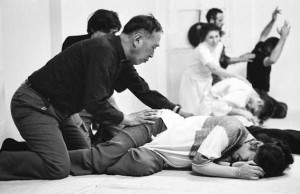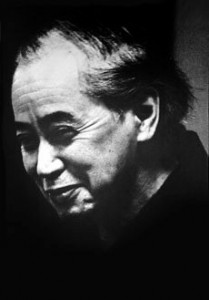
Yuki – Touch Healing – Touch Play
In the Far East there is a concept concerning human energy or life force which they call Ki. In China it is called Chi, as in Tai Chi. Haruchika Noguchi was the founder of Sei Tai a Japanese method of healing movement. He describes Ki as the force behind the form of the body and its processes, he was the founder of Sei Tai. He says it is the Ki that directs cellular processes, and causes them to grow in the correct shape and size to form our human body. The movement of our heart, for instance, is not the same, Noguchi says, as a piece of chalk being moved around. Our movements come from within, directed by Ki. In its expression, Ki is felt as our motivations. From these motivations we move an arm or leg. But more important still, without motivations, as occurs with some people who retire and lose their motivations, their being loses its health. Therefore, Noguchi says that instead of treating the shell, the body, one ought in such cases to treat the Ki and to restore the quality of its positive motivations.
Most ancient cultures have developed explanations of this subtle energy field within and around the body. Western science and medicine is now beginning to be able to demonstrate it also. Dr. Dolores Krieger, who is a professor of nursing at New York University became interested in the subject after studying the work of Oscar Esteban, a Hungarian healer. After studying with Dora Kunz, Kreiger was able to work with the energy field in effective healing. She went on to teach ‘therapeutic touch’ to nurses in a master’s level course at New York University.
Valerie Hunt, a professor of kinesiology at UCLA has been able to demonstrate the presence and importance of the energy field using a electromyograph. This is an electronic device measuring electrical activity in the muscles.
The Japanese teach that when you place your hands on another persons body, you respond to it. You will feel the energy field if you take time to watch your sensations with awareness. Sometimes your hands feel cold, or there is the sensation of ants crawling on them. If there is a cold response, it may be that there is a lack of vitality in that part of their body. You must continue Yuki – that is, directing Ki energy – until the hands return to normal. They also say that you will gradually learn to work with these subtle feelings with greater discernment through practise. Noguchi says that on the part of the person receiving Yuki there are observable changes. Their pulse rate increases, they feel more relaxed and sometimes sleepy. The effects are 1) relaxation. 2) heightened sensitivity. 3) discharge. There is certainly a very real help from Yuki, and at present there is much research into how such techniques can be used in healing the sick.
The way I was taught yuki was very simple and without any theoretical background. It is as follows:
The Practice Of Yuki
1 – The starting point is that the receiver can choose whether to lie down, sit or stand. They become quiet and receptive to the giver. The giver allows their own inner-directed movements, as occurs in katsugen-undo. But the giver holds in mind that what they are allowing is in response to the receiver. I have found a useful way to begin is to be about three feet away from the receiver and hold your hands out towards them as if warming your hands. From there follow the delicate urges to move. The idea is not to massage the person, but touch is allowed as you simply follow what your hands and body want to do.
2 – The receiver can also allow their own movements in response to the contact with the giver. In watching the Japanese use yuki, there were all levels of response. Sometimes the receiver remains very quiet, even sleepy. Other times both partners move into a lovely dance of responsive spontaneous movement and contact – or a fast moving play with lots of laughter. The contact may be delicate or full. Very often the hands of the giver do not touch the receiver, but move at a distance from them.
3 – The receiver is to be respected. In Western groups who were unfamiliar with ‘tenshin’ or waiting, on occasion I have seen the giver drop any openness to the needs of the receiver and consciously decide what ought to happen, and drag a receiver to their feet. The giver felt that was where they ought to go. The inner situation or movements of the receiver were thus completely ignored. This non respect for another person’s integrity is not the way to use yuki. The interaction between giver and receiver in yuki, if allowed to develop naturally, often shifts to a mutual giving and receiving.
 |
People using Yuki |
The experience of yuki is one of the most delightful facets of Sei Tai. Not only does it develop sensitivity in a relationship, but it also enables two people to discover a world of non verbal communication and meeting. It develops the sensitivity of responsiveness necessary in intimate relationships. Finding that the Japanese had developed this gentle way of strangers meeting and touching showed me an unsuspected side to their culture. Teaching it in the West people have sincerely thanked me for showing them how to discover their own beauty and flow in meeting another person.
Working With A Sick Person
The Japanese practitioners of Seitai say that yuki can be useful if a person is feeling unwell. If the person you are giving yuki to is actually ill, there need be no change in the way you give it. It is best if you have practised inner-directed movement for some time to feel easy with allowing spontaneous movement. It is enough to hold the sick person in mind and open yourself to what arises from within. It doesn’t even matter if physical contact is not made.
To Start Your Own Spontaneous Movement
What follows is not the method used by Sei Tai, but something I developed. In Sei Tai no vocal sounds are ever used. I found great release by allowing spontaneous sound emerge from me. It adds an emotional dimension to an otherwise silent practice.
1 – When ready, stand in the space, listen to the music and drop unnecessary tensions. Remind yourself that for the next few minutes you are going to let your body play. You are going to let it off the lead.
2 – Open your mouth wide with head slightly dropped back and simulate yawns. As you do so notice whether a natural yawn starts to make itself felt. If it does, allow it to take over and have a really luxurious yawn. Any following impulse to yawn again should be allowed.
3 – Let the yawns come one after the other if they want to. Without acting it out, let the impulse to yawn take over your body, not just your mouth and face. So if the urge to move includes the arms or elsewhere, let it happen.
